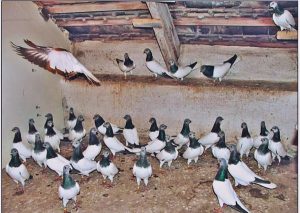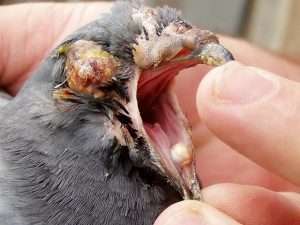2. Prevention of epidemics between the yard and the outside world
It is the most important part of epidemic control. The outside world is full of endless pathogens. It is very important that these pathogens are not allowed into the yard and especially the lofts.
When considering the prevention of epidemics between the yard and the outside world, we treat our flock and the place it is housed as a unit, and as such we try to use every available method to keep it as isolated from the outside world as possible.
This part of the prevention of epidemics is one of the most crucial aspects of preserving pigeons’ health, as the boundary of the yard is what separates the flock from the outside world, buzzing as it is with pathogens. It is inside the yard that pigeons spend the most time, and so it is here that they are most often exposed to infection (e.g. wild birds, rodents); this is the area whose boundary the fancier crosses many times each day, each time carrying in huge numbers of pathogens with him.
The yard cannot be made airtight, of course, and so in theory the wind can bring in pathogens, though the practical significance of this is very minimal. Visits by wild birds represent a much greater danger, as a wild pigeon, sparrow etc. flying in amidst the flock will always carry pathogens which might infect the pigeons. So the presence of wild birds must be restricted as much as possible. The lofts must be designed such that wild birds cannot fly into them in any case.
Pigeon fanciers themselves are a high risk of infection to their flocks. Firstly, they can introduce large amounts of pathogens into the flock from the outside world on their shoes, clothing and skin. Secondly, and it is the most dangerous, when pigeon fanciers introduce newly acquired pigeons carrying pathogens into the loft.
*
A special and extremely important part of the prevention of epidemics is the introduction to the flock of new pigeons acquired from elsewhere. Possibly the greatest damage in pigeon-keeping is associated with the inclusion of newly-purchased pigeons, and it is surprising how courageously some fanciers will put their freshly acquired birds, whose state of health is a complete mystery, among their cherished favourites. It is not rare for a flock to decline in catastrophic measure as a result of a single diseased pigeon being introduced into it, losing the best of its most beautiful specimens.
One of the most important things in pigeon breeding:
USE QUARANTINE!!!
Mankind invented the quarantine back in ancient times. Later, it was introduced in more and more places, mainly because of the great plague epidemics, even though it was not known then that plague and other infectious diseases were spread by micro-organisms. It has been observed that if a plague patient gets among healthy people, after a while most of them will catch the plague. Therefore, the sick were kept away and separated from the healthy, i.e. quarantined. The rules of quarantine were so strict that those who broke them were punished with death. This goes to show how significant a measure it is.
With a little care and minimal cost, you can easily set up an inexpensive but treasured quarantine in your own backyard.
The primary objective of the quarantine is that an infectious specimen not be allowed to be among the other pigeons. However it is not only visibly diseased birds that are infectious; those appearing to be healthy can also spread pathogens. This is the main problem.
Every infectious disease has its lag period, the period of time, usually a few days or weeks, when the animal is already infected, but does not yet display any symptoms, that is, appears to be healthy. But, and here is the point, it is capable of releasing pathogens before any symptoms of the illness appear, that is, independently from them.
Similarly, an animal that has survived a disease no longer displays its symptoms, but can still release its pathogens in huge quantities, continuing to infect its environment. Furthermore, there are pathogens – the salmonellas that cause paratyphoid are a typical example – which can remain in the pigeon’s body for a long time, even a number of years, without displaying any symptoms. Such a pigeon appears to be healthy, but once in your flock it can release salmonella strains that your pigeons have never encountered, thus setting a real epidemic in motion.
The development and operation of the quarantine
Quarantine is only safe if the new pigeon, whose health status is unknown, does not come into contact with other pigeons in any way. It follows that the quarantine and the other lofts cannot be in the same airspace. If possible, the cage designated for quarantine should be in a separate building. If this is not possible, it should be as far away from the flock as possible. If they are in a common air space, there should be no air movement from the quarantine to the other pigeons.
.
The size of the quarantine
The capacity of the quarantine should be tailored to the flock in question, bearing in mind its size and the frequency of purchases and new admissions. Of course we should be aware of our options: the quarantine can be a separate building, but it can easily be a home-made wire cage which holds a couple of pigeons. It is not the size or “gleam” of the quarantine that matters, but how well we observe the rules associated with it.
Equipping the quarantine
The quarantine must be equipped with designated feeders and drinkers. It is a fundamental principle that things can only be brought into the quarantine, not taken out, or at least only under certain conditions, and only after being thoroughly disinfected.
As one can spread pathogens oneself (through dirt attached to shoes, clothes and the skin), systematic use of separate clothes and especially shoes, which are only used in or directly around the quarantine, is recommended. It is a good idea to place a tray in front of the quarantine, into which we place a large sponge previously soaked in water rich in disinfectant. This gives us a simple but effective shoe disinfectant. If we have been working in the quarantine, we should use this disinfectant upon leaving without fail, and in addition we should, of course, always wash our hands thoroughly! We should plan the day’s feeding and cleaning programme, etc., such that we always deal with the healthy flock first. Leave the inspection of the quarantine to the end of the day’s duties, after which we do not return directly to the main flock.
Period of quarantine
The lag period of diseases varies, and is usually a matter of days or weeks. No absolute value can be given for the period of quarantine, but a period of at least three or four weeks is necessary for the reliable prevention of epidemics. This can depend on a number of factors, e.g. whether our flock has been vaccinated against paramyxovirus. As the lag period of this illness can be as long as six weeks, in the case of an uninoculated and thus susceptible flock, a minimum of six weeks’ quarantine is recommended.
Tasks associated with the quarantine
During the period of quarantine we observe the new specimen on a regular basis to see whether it shows any symptoms of some disease. Meanwhile we treat it for worms, which equally refers to internal and external parasites, and also treat against canker (trichomoniasis) and coccidiosis. If the feeding of the pigeon in its previous location was very different, then during this time we gradually make it accustomed to the feeding mix we use.
Antibiotic treatment may be necessary during quarantine, but it is not advisable to do this routinely. It is best to ask your vet for a laboratory test. In this case, it is best for the vet to take a sample directly from the pigeon itself (throat secretions and faeces). If this is not feasible, then collect faeces for a few days and take this for testing. The test not only reveals the pathogens present in the pigeon, but also which antibiotic to use.
During quarantine, we should also aim to stimulate the pigeon’s immune system. Vaccination may be necessary, so it is good to know the vaccination history of the pigeon. It is very important to bring the new pigeon up to the same vaccination level as the flock. In other words, it should receive the same vaccinations as the members of your flock have received. If the pigeon did not receive them at the previous owner (or you are not sure), it must be vaccinated during quarantine.
Vaccinations can prolong the quarantine period.
After three (or more) weeks, and after the necessary examinations, treatments and vaccinations have been carried out, the new pigeon, if it has been found to be healthy, can be introduced into the flock.








